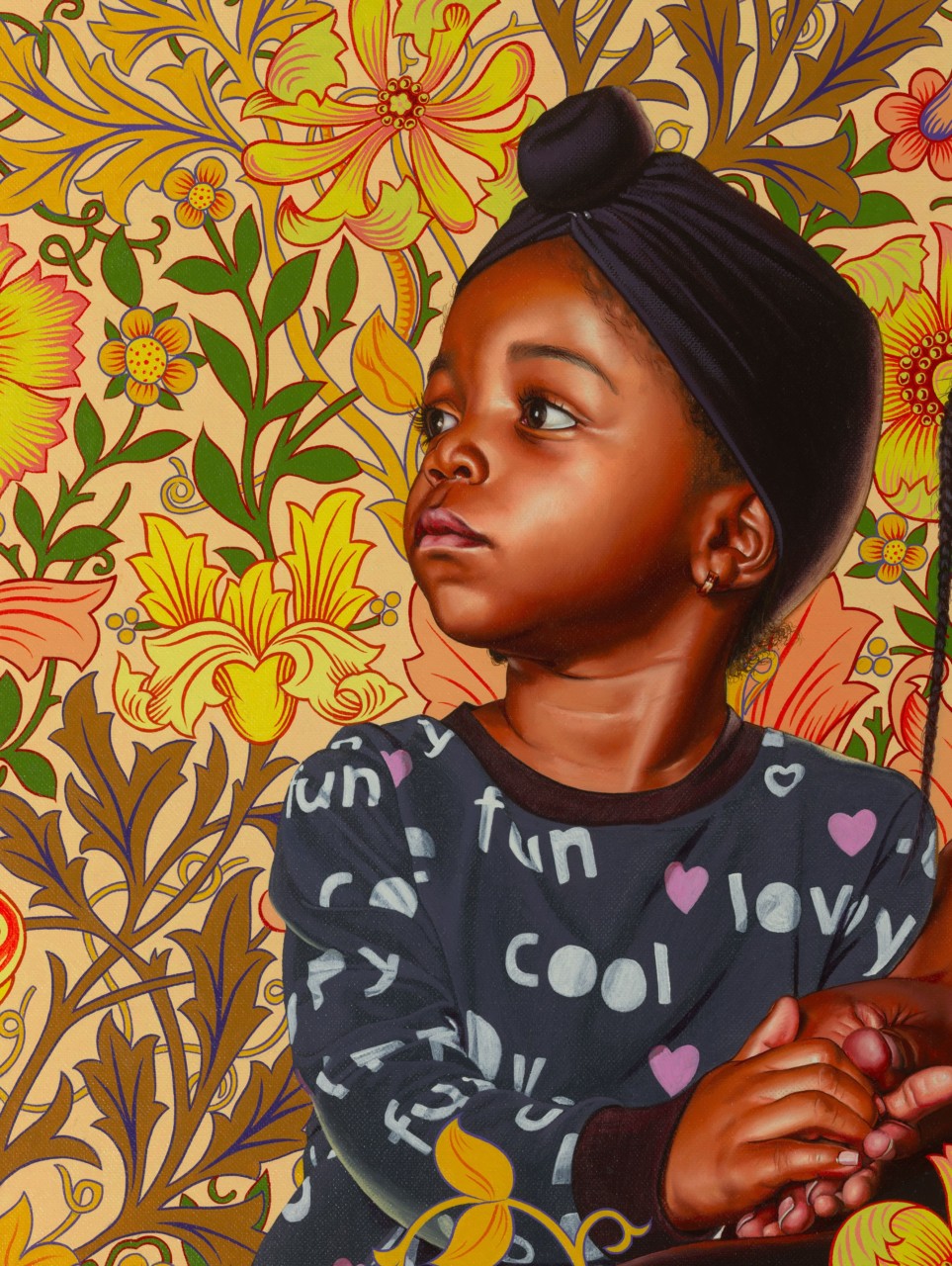


Kehinde Wiley, 'Portrait of Asia-Imani, Gabriella-Esnae, and Kaya Palmer' (detail), 2020. © Kehinde Wiley. Courtesy the artist and Stephen Friedman Gallery, London.
Quanna Noble of Dalston stands looking straight out at her audience. She wears special edition Converse All Stars with Adidas leggings and the portrait reproduces her gel nail art in minute detail. One reviewer of this exhibition eloquently described the expressions of Wiley’s models as ‘unfuckwithable’. Wiley finds his models through a process he refers to as ‘street casting’ – literally going out into the streets and approaching people cold. What attracts him is a certain attitude, a person’s style, their ‘carriage’. A lot of people say ‘no’ to him, but a good few agree to be photographed as subjects for his paintings.
The exhibition just opened at the William Morris Gallery in Walthamstow, east London, is distinct within Wiley’s work for a number of reasons. Wiley has painted presidents – most famously Barack Obama – and rock royalty, like his commissioned portrait of Michael Jackson. The artist has also been noted for his use of anonymous models: typically, street cast young black men transposed into pastiches of historical paintings. In The Yellow Wallpaper, the six oval portraits are of named individuals, depicted more or less naturalistically against the signature Wiley background.
This is also the first time Wiley has made an exhibition featuring an all-female cast of models. When he was first beginning to gain critical attention, Wiley’s work was noted for a certain eroticism in his paintings of young African-American men. The sensual rendering of skin – all satiny perfection and copper glow – remains a constant and is a foundation of the underlying political project in Wiley’s life, namely the corrective depiction of people too routinely presented in only negative terms. It’s about race, and it’s about class. At the William Morris Gallery, it’s also about gender. The background to Quanna Noble’s portrait is based on the Honeysuckle wallpaper produced by the William Morris company in the 1880s. It should be noted that this design was in fact by Morris’ youngest daughter May Morris – a formidable businesswoman and designer in her own right, and subject of the exhibition that immediately preceded Wiley at the gallery.
The Yellow Wallpaper is the title of a text by the American author Charlotte Perkins Gilman, a semi-autobiographical and proto-feminist tale of a woman confined to her bedroom after being diagnosed with ‘hysteria’. It is a parable of the dangers of denying women their independence. In all six portraits, Wiley’s female models are so manifestly comfortable in their own skin, so self-possessed that it would be superfluous to transpose them into history paintings to make a point about their essential nobility.
Gilman and May Morris were friends, incidentally, adding an additional layer of interest to the fascinating confluence of makers and thinkers assembled in Wiley’s show. Kehinde Wiley first came to know the designs of the William Morris Company while helping his mother sell bric-a-brac in South Central Los Angeles in the 1980s. Drawn instinctively to colour and intricate patterning, Morris’ late 19th century designs, intended to bring art into ordinary middle class homes, have been a regular source for Wiley’s paintings. Tendrils of the English flora beloved of Morris break free from their geometrical frames and twine themselves around the sitters. In Portrait of Asia-Imani, Gabriella-Esnae, and Kaya Palmer, 2020, the immaculate white socks of the little girl droop around slender ankles in tender contrast to the curlicues of stylised foliage. In Portrait of Mojisola Elufowoju, 2020, the delicate climbing rose half screens the body of the sitter, in counterpoint to her assertive pose.
Wiley’s work is at home here, in the museum dedicated to Morris, the great socialist, radical, democratiser of art, champion of craftsmanship. While we can all have our 15 seconds of fame on Instagram now, to be immortalised in the artform previously reserved for the aristocratic, the famous, or at very least the wealthy, means something. No museum can afford to ignore the people who live their lives outside of the museum gates. Kehinde Wiley’s paintings address centuries of inequality and lack of representation in a joyous, empowering contemporary portraiture. Those paintings that Wiley titles with the historic work that lends the compositional framework - Equestrian Portrait of King Philip II, 2009, or Saint Jerome Hearing the Trumpet of the Last Judgment, 2018, for example – are more overtly political perhaps. Here in London, in this exhibition of new work that is so anchored to place, we have something that operates in a slightly quieter register, but deploys its tactics to no lesser an effect.
Caroline Douglas
Director
William Morris Gallery, Lloyd Park, Forest Road, London E17 4PP. Open Tuesday-Sunday 10.00-17.00. Exhibition continues until 25 May 2020. www.wmgallery.org.uk
Kehinde Wiley's Narrenschiff, 2017 will also be on display from the 14 May 2020 at The Box, Plymouth which was presented by the Contemporary Art Society through the Collections Fund at Frieze, 2018/19